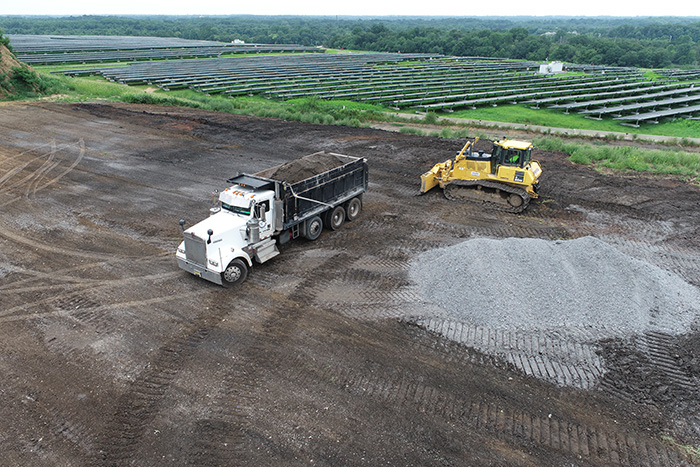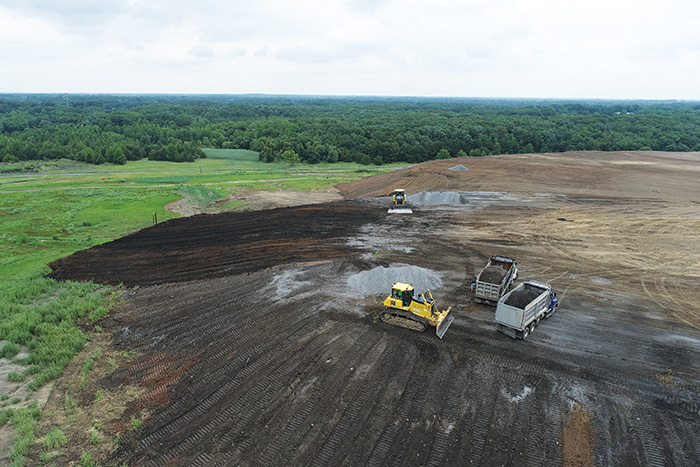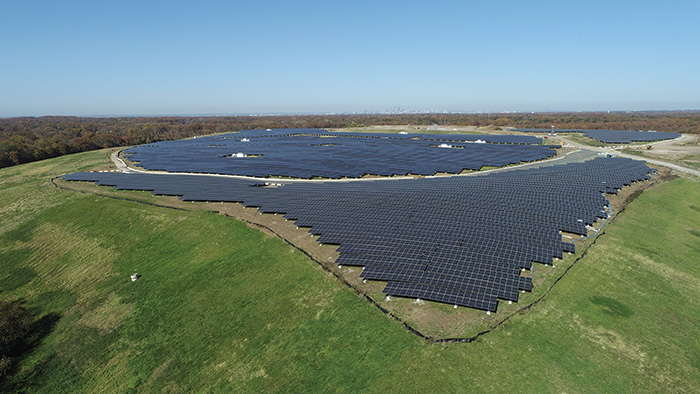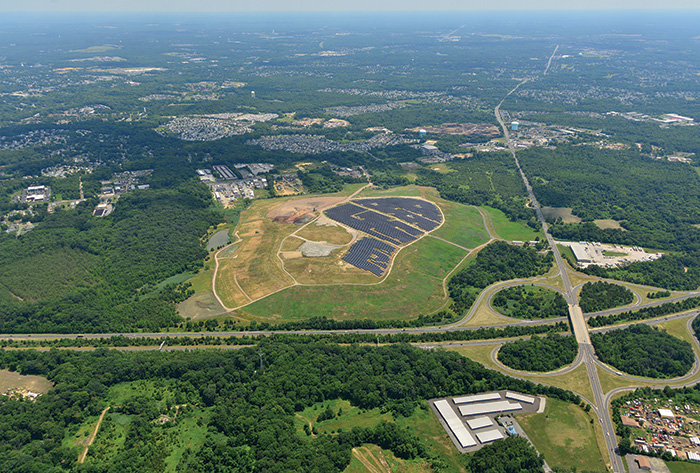Sustainable strategies for addressing differential settlement and custodial care at landfills.
By Daryl O’Dell and Gary DeFranco
Kinsley’s Deptford Renewable Energy Center (previously known as Kinsley’s Landfill, Inc.) in Deptford Township, NJ, is an interesting case study highlighting the issues and opportunities associated with maintaining a solid waste landfill in the post-post-closure period, aka the custodial care period that landfills enter after completing 30 years of post-closure. Developing and implementing an economically sustainable custodial care model has given Kinsley’s the financial strength needed to care for the facility for years to come. Recognized for the innovative, economically sustainable model of custodial care at closed landfills, the project received the 2022 NJ SWANA Sustainability Award.

Closed Landfill Reaches End of Post-Closure Period
RCRA Subtitle D regulations governing landfills were promulgated in the late 1980s and became effective in 1990. Subtitle D requirements led to the closure of many landfills in the early 1990s, which is why so many landfills are now leaving post-closure care and entering custodial care.
Kinsley’s Deptford Renewable Energy Center is a closed 137-acre landfill located on 194 acres in Deptford Township, Gloucester County, NJ. From the 1960s through 1987, Kinsley’s Landfill accepted municipal solid waste from Gloucester County and neighboring communities. After ceasing to accept waste, the facility closed in compliance with a New Jersey Department of Environmental Protection (NJDEP) approved Closure and Post Closure (CPC) Care Plan and operated in compliance with the Plan. In 2015, Kinsley’s negotiated with the NJDEP to develop and implement the economically sustainable modified CPC Plan, which extended Kinsley’s post-closure care for another 10 years beyond the original 30-year post-closure maintenance period, until 2027.

Pragmatic Approach Needed to Fund Ongoing Maintenance and Monitoring
Kinsley’s recognized that costs for maintenance and monitoring go beyond the typical 30-year post-closure period. The most significant issue is that the landfill continues to produce landfill gas and generate leachate. The site had reserved funds for the 30-year post-closure period, but was now required to identify the means and funds for extended care. To extend care beyond 30 years, additional funding would be required.
In conjunction with local and state officials, Kinsley’s developed a pragmatic approach with sustainable activities capable of generating sufficient revenue to maintain and monitor the landfill for the 10-year period. The program’s two key revenue generating components are a soil reuse and regrading program to restore pre-settlement landfill slopes and development of a solar electric generating system. Operators estimate that the revenue obtained from soils regrading and solar development will cover the extended 10-year post-closure period.
“The key to the project’s success has been getting rid of the mindset that the landfill is only a liability and implementing the new mindset that the facility is a long-term renewable resource,” said Dan Edwards, President of Transtech Industries, Inc, Kinsley’s parent company.
Reuse and Regrading
Kinsley’s compacted low permeability clay cover performed as expected and had good leakage performance when placed, but the freeze/thaw cycle and settlement over 30 years allowed leakage to increase over time. A permeability study conducted nearly 20 years ago showed that the permeability of the cover had doubled in the decade since it was first placed; fissures, cracks, and ponding due to settlement was suspected to be driving the increase in leachate generation. In the early 2000s, Kinsley’s received approval to regrade the landfill to address settlement as a component of post-closure care.
Facility operators reasoned that they could decrease their operations and maintenance costs for leachate management if they regraded to improve stormwater runoff. At the same time, the revenue they would receive from the regrading material could help them build up the reserve needed for their eventual post-post-closure (custodial care) responsibilities.
The regrading program is designed to restore the plateau and slopes to pre-settlement conditions optimal for promoting storm water runoff while directing the runoff to existing onsite controls. The approach also reduces the potential for leachate generation. The landfill accepts a variety of clean and regulated soils and fill materials from construction projects, dredging projects, filter material from water treatment plants, or other materials meeting the facility’s NJDEP-approved site-specific Material Acceptance Protocol (MAP), which was created based on Tetra Tech’s site-specific material assessment parameter review. Having pre-approved acceptance criteria in the MAP means that Kinsley’s can accept materials in a timely manner and does not need to make time-consuming individual approval requests to NJDEP.
The materials are used to restore grade and eliminate low areas where stormwater collects and infiltrates. The facility regrading also helps advance additional beneficial end uses for the landfill, including the development of Kinsley’s Deptford Renewable Energy Center.

Solar Array Development
Kinsley’s implemented a phased solar array program following its ranking as #1 among more than 700 New Jersey landfills in PSG&E’s Solar 4 All® study on closed landfills. Phase I, completed in 2017, is an 11.2 megawatts DC (MW DC) rigid solar array project. Phase II, completed in 2020, expanded the solar field’s footprint to a total of approximately 37 acres, producing a combined 16.2 MW DC of solar power. The clean solar energy generated by this facility avoids about 80,000 tons of CO2 per year, calculated using EPA’s Greenhouse Gases Equivalencies Calculator and other industry calculation resources. The existing solar array powers about 14,000 homes.
Kinsley’s is continuing progressive filling in preparation for a possible Phase III solar expansion (estimated at 10 MC DC), which would occupy the rest of the undeveloped landfill plateau on approximately 20 acres of available land. Partnering with a knowledgeable engineering firm and encouraging and cultivating open and collaborative dialog with both township officials and state regulators has led to the successful solar projects, which are environmentally friendly energy production facilities that further help fund long term care of the facility while helping to reduce post closure care O&M costs.

Proactive Approach Enables Long-Term Care
According to Dan Edwards, the project demonstrated to Kinsley’s how complex tasks can be accomplished when working with a dedicated team that is laser focused on pursing innovative solutions for new and challenging problems. “Along the way it brought with it a new and useful purpose for the facility and the organization.”
As a result, Kinsley’s Deptford Renewable Energy Center’s sustainability program is an economically sustainable model of custodial care that can be replicated at other closed landfills, which will be absolutely critical in the coming years. Kinsley’s efforts have resulted in continued financial strength, which enables them to care for the facility into the future. | WA
Daryl O’Dell, PE, P Eng., is a Client Manager at Tetra Tech with 25 years of experience in construction materials testing and solid waste consulting. He has experience in landfill design and permitting, landfill gas design, and renewables, including compressed natural gas and solar. Daryl has extensive experience working with New Jersey Department of Environmental Protection and clients during post-closure and custodial care, working with both to find sustainable solutions to long-term care and funding mechanisms for solid waste facilities. He can be reached at [email protected].
Gary DeFranco is Vice President of Operations for Transtech Industries, Inc. He is an environmental professional with experience in waste management, innovative self-financing site remediation projects, independent power production, industrial wastewater treatment, and industrial site cleanups. He has served as Supervisor of Solid Waste Programs for the Middlesex County Department of Solid Waste Management, Manager of Technical Services for United Environmental Services, Inc., Operations Manager for Edgeboro Disposal, Inc., and General Manager of Kinsley’s Landfill, Inc. He can be reached at [email protected].
